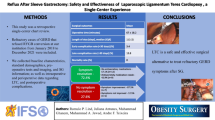Abstract
Background
Robotic techniques are routinely used in urological and gynecological procedures; however, their role in general surgical procedures is limited. A robotic technique has been successfully adopted for a minimally invasive Heller myotomy procedure for achalasia. This study aims to compare perioperative outcomes following open, laparoscopic, and robotic Heller myotomy.
Methods
This study is a multicenter, retrospective analysis utilizing a large administrative database. The University Health System Consortium (UHC) is an alliance between academic medical centers and affiliate hospitals. The UHC database was accessed using International Classification of Diseases, Ninth Revision, Clinical Modification codes and analyzed.
Results
2,683 patients with achalasia underwent Heller myotomy between October 2007 and June 2011. Myotomy was performed by open surgery (OM) in 418 patients, by laparoscopic approach (LM) in 2,116, and by robotic approach (RM) in 149. Comparison between LM and RM groups demonstrated no significant difference in mortality (0.14 vs. 0.0%; P = 1), morbidity (5.19 vs. 4.02%; P = 0.7), intensive care unit (ICU) admission (6.62 vs. 3.36%; P = 0.12), length of stay (LOS) (2.70 ± 3.87 days vs. 2.42 ± 2.69 days; P = 0.34), or 30-day readmission (1.41 vs. 2.84%; P = 0.27). However, hospital costs were significantly lower for the LM group (US $7,441 ± 7,897 vs. US $9,415 ± 5,515; P = 0.0028). Comparison between OM and RM demonstrated significant lower morbidity (9.08 vs. 4.02%; P = 0.02), ICU admission rate (14.01 vs. 3.36%, P = 0.0002), and LOS (4.42 ± 5.25 days vs. 2.42 ± 2.69 days; P = 0.0001).
Conclusions
The perioperative outcomes are superior in LM and RM groups when compared with OM. The outcomes for the LM and RM group are comparable, with the robotic group having slightly improved results, although with increased costs. We conclude that robotic surgery is equivalent in safety and efficacy to laparoscopic Heller myotomy, and feel that the increased cost should come down as surgeons and manufacturers work together on cost reduction strategies.
Similar content being viewed by others
References
Vaezi MF, Richter JE (1999) Diagnosis and management of achalasia. Am J Gastroenterol 94:3406–3412
Patti MG, Fisichella PM, Perretta S, Galvani C, Gorodner MV, Robinson T, Way LW (2003) Impact of minimally invasive surgery on the treatment of esophageal achalasia: a decade of change. J Am Coll Surg 196(5):698–703; Discussion 703–5
Schuchert MJ, Luketich JD, Landreneau RJ, Kilic A, Gooding WE, Alvelo-Rivera M, Christie NA, Gilbert S (2008) Pennathur: a minimally-invasive esophagomyotomy in 200 consecutive patients: factors influencing postoperative outcomes. Ann Thorac Surg 85(5):1729–1734
Heniford BT, Matthews BD, Kercher KW, Yavorski R, Greer SF, Goldstein SL, Deal SE, Paccico T, Drake S, Colvin A, Cyzner R, Sing RF (2001) Laparoscopic anterior esophageal myotomy and Toupet fundoplication for achalasia. Am Surg 67(11):1059–1065; Discussion 1065–7
Khajanchee YS, Kanneganti S, Leatherwood AE, Hansen PD, Swanström LL (2005) Laparoscopic Heller myotomy with Toupet fundoplication: outcomes predictors in 121 consecutive patients. Arch Surg 140(9):827–833; Discussion 833–4
Nguyen NT, Hinojosa MW, Finley D, Stevens M, Paya M (2004) Application of robotics in general surgery: initial experience. Am Surg 70(10):914–917
Huffmanm LC, Pandalai PK, Boulton BJ, James L, Starnes SL, Reed MF, Howington JA, Nussbaum MS (2007) Robotic Heller myotomy: a safe operation with higher postoperative quality-of-life indices. Surgery 142(4):613–618; Discussion 618–20
Maeso S, Reza M, Mayol JA, Blasco JA, Guerra M, Andradas E, Plana MN (2010) Efficacy of the Da Vinci surgical system in abdominal surgery compared with that of laparoscopy: a systematic review and meta-analysis. Ann Surg 252(2):254–262
Reynoso JF, Tiwari MM, Tsang AW, Oleynikov D (2011) Does illness severity matter? A comparison of laparoscopic esophagomyotomy with fundoplication and esophageal dilation for achalasia. Surg Endosc 25(5):1466–1471
Talamini MA, Chapman S, Hogan S, Melvin WS (2003) A prospective analysis of 211 robotic-assisted surgical procedures. Surg Endosc 17(10):1521–1524
Ayav A, Bresler L, Brunaud L, Boissel P (2004) Early results of one-year robotic surgery using the Da Vinci system to perform advanced laparoscopic procedures. J Gastrointest Surg 8(6):720–726
Kilic A, Schuchert MJ, Pennathur A, Gilbert S, Landreneau RJ, Luketich JD (2009) Long-term outcomes of laparoscopic Heller myotomy for achalasia. Surgery 146(4):826–831; Discussion 831–3
Cowgill SM, Villadolid D, Boyle R, Al-Saadi S, Ross S, Rosemurgy AS (2009) Laparoscopic Heller myotomy for achalasia: results after 10 years, 2nd. Surg Endosc 23:2644–2649
Rosemurgy AS, Morton CA, Rosas M, Albrink M, Ross SB (2010) A single institution’s experience with more than 500 laparoscopic Heller myotomies for achalasia. J Am Coll Surg 210(5):637–645 645-7
Jeansonne LO, White BC, Pilger KE, Shane MD, Zagorski S, Davis SS, Hunter JG, Lin E, Smith CD (2007) Ten-year follow-up of laparoscopic Heller myotomy for achalasia shows durability. Surg Endosc 21(9):1498–1502
Iqbal A, Haider M, Desai K, Garg N, Kavan J, Mittal S, Filipi CJ (2006) Technique and follow-up of minimally invasive Heller myotomy for achalasia. Surg Endosc 20(3):394–401
Melvin WS, Dundon JM, Talamini M, Horgan S (2005) Computer-enhanced robotic telesurgery minimizes esophageal perforation during Heller myotomy. Surgery 138(4):553–558; Discussion 558–9
Galvani C, Gorodner MV, Moser F, Baptista M, Donahue P, Horgan S (2006) Laparoscopic Heller myotomy for achalasia facilitated by robotic assistance. Surg Endosc 20(7):1105–1112
Horgan S, Galvani C, Gorodner MV, Omelanczuck P, Elli F, Moser F, Durand L, Caracoche M, Nefa J, Bustos S (2005) Robotic-assisted Heller myotomy versus laparoscopic Heller myotomy for the treatment of esophageal achalasia: multicenter study. J Gastrointest Surg 9(8):1020–1029
Quan H, Sundararajan V, Halfon P et al (2005) Coding algorithms for defining comorbidities in ICD-9-CM and ICD-10 administrative data. Med Care 43(11):1130–1139
Disclosures
Authors Abhijit Shaligram, Jayaraj Unnirevi, Vishal Kothari, Anton Simorov and Dmitry Oleynikov have no conflict of interest or financial ties to disclose.
Author information
Authors and Affiliations
Corresponding author
Rights and permissions
About this article
Cite this article
Shaligram, A., Unnirevi, J., Simorov, A. et al. How does the robot affect outcomes? A retrospective review of open, laparoscopic, and robotic Heller myotomy for achalasia. Surg Endosc 26, 1047–1050 (2012). https://doi.org/10.1007/s00464-011-1994-5
Received:
Accepted:
Published:
Issue Date:
DOI: https://doi.org/10.1007/s00464-011-1994-5




